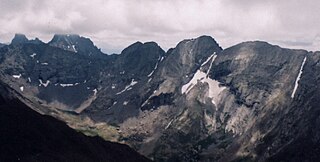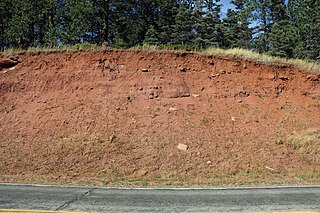
The Sangre de Cristo Mountains are the southernmost subrange of the Rocky Mountains. They are located in southern Colorado and northern New Mexico in the United States. The mountains run from Poncha Pass in South-Central Colorado, trending southeast and south, ending at Glorieta Pass, southeast of Santa Fe, New Mexico. The mountains contain a number of fourteen thousand foot peaks in the Colorado portion, as well as several peaks in New Mexico which are over thirteen thousand feet.

Riojasaurus was a herbivorous sauropodomorph dinosaur named after La Rioja Province in Argentina where it was found in the Los Colorados Formation in the Ischigualasto-Villa Unión Basin by José Bonaparte. It lived during the Late Triassic and grew to about 6.6 metres (22 ft) long. Riojasaurus is the only known riojasaurid to live in South America.

Dissorophidae is an extinct family of medium-sized temnospondyls that flourished during the late Carboniferous and early Permian periods. The clade is known almost exclusively from North America.

Riojasuchus is an extinct genus of ornithosuchid archosaur from the Late Triassic (Norian) of Argentina. Ornithosuchidae was a widespread family of facultatively bipedal pseudosuchians with adaptations for scavenging. Riojasuchus is notable as one of the youngest and most complete members of the family. The type and only known species, Riojasuchus tenuisceps, was named and described by José Bonaparte in 1967. It was one of the first of many well-preserved Triassic archosaurs to be discovered in Argentina. The holotype specimen, PVL 3827, was found in the Los Colorados Formation of the Ischigualasto-Villa Unión Basin in northwestern Argentina.

Platyhystrix is an extinct temnospondyl amphibian with a distinctive sail along its back, similar to the unrelated synapsids, Dimetrodon and Edaphosaurus. It lived during the boundary between the latest Carboniferous and earliest Permian periods throughout what is now known as the Four Corners, Texas, and Kansas about 300 million years ago.

Columbia Point is a high mountain summit of the Crestones in the Sangre de Cristo Range of the Rocky Mountains of North America. The 13,986-foot (4,263 m) thirteener is located 5.5 miles (8.8 km) east by south of the Town of Crestone in Saguache County, Colorado, United States. The Crestones are a cluster of high summits in the Sangre de Cristo Range, comprising Crestone Peak, Crestone Needle, Kit Carson Peak, Challenger Point, Humboldt Peak, and Columbia Point.

Limnoscelis was a genus of large diadectomorph tetrapods from the Late Carboniferous to early Permian of western North America. It includes two species: the type species Limnoscelis paludis from New Mexico, and Limnoscelis dynatis from Colorado, both of which are thought to have lived concurrently. No specimens of Limnoscelis are known from outside of North America. Limnoscelis was carnivorous, and likely semiaquatic, though it may have spent a significant portion of its life on land. Limnoscelis had a combination of derived amphibian and primitive reptilian features, and its placement relative to Amniota has significant implications regarding the origins of the first amniotes.

Oestocephalus is an extinct genus of aïstopod tetrapodomorphs that lived during the Carboniferous period. Fossils have been found in the Czech Republic, and in Ohio and Illinois in the United States. It is the type genus of the family Oestocephalidae, although it used to be assigned to the family Ophiderpetontidae, which is now considered paraphyletic. It was named by Edward Drinker Cope in 1868 and now contains two species, O. amphiuminus and O. nanum.
Trihecaton is an extinct genus of microsaur from the Late Pennsylvanian of Colorado. Known from a single species, Trihecaton howardinus, this genus is distinctive compared to other microsaurs due to possessing a number of plesiomorphic ("primitive") features relative to the rest of the group. These include large intercentra, folded enamel, and a large coronoid process of the jaw. Its classification is controversial due to combining a long body with strong limbs, features which typically are not present at the same time in other microsaurs. Due to its distinctiveness, Trihecaton has been given its own monospecific family, Trihecatontidae.
The Garita Creek Formation is a geologic formation in New Mexico that contains vertebrate fossils characteristic of the Carnian Age of the late Triassic.

Oestocephalidae is an extinct family of Late Carboniferous aistopod tetrapodomorphs. Fossils have been found from Ohio, Illinois, and Colorado in the United States; England; and the Czech Republic. It includes the genera Coloraderpeton and Oestocephalus. Oestocephalids have robust skulls and narrow, rounded snouts. They possess heavily ossified gastralia and dorsal osteoderms. Like other aïstopods, oestocephalids were elongate, having approximately 110 vertebrae. Oestocephalidae was named in 2003, with the type species being Oestocephalus amphiuminus.
Kayentavenator is a genus of small carnivorous tetanuran dinosaur that lived during the Early Jurassic Period; fossils were recovered from the Kayenta Formation of northeastern Arizona and were described in 2010.

Limnoscelidae is a family of carnivorous diadectomorphs. They would have been the largest terrestrial carnivores of their day, the other large carnivores being aquatic or semi aquatic labyrinthodont amphibians. The Limnoscelidae themselves, being close to the ancestry of amniotes, would have been well adapted land animals, but still dependent on anamniote eggs, and possibly having a tadpole stage. Contrary to the more advanced herbivorous diadectids, the teeth retained labyrinthodont infolding of the enamel, and were pointed and slightly recurved at the tip.
Desmatodon is an extinct genus of diadectid reptiliomorph. With fossils found from the Kasimovian (Missourian) stage of the Late Carboniferous of Pennsylvania, Colorado, and New Mexico in the United States, Desmatodon is the oldest known diadectid. Two species are currently recognized: the type species D. hollandi and the species D. hesperis.

Cutleria is an extinct genus of basal sphenacodontids or derived stem-sphenacodontoid known from the Early Permian period of Colorado, United States. It contains a single species, Cutleria wilmarthi.
The Baldy Hill Formation is a geologic formation in northeastern New Mexico and western Oklahoma. It preserves fossils dating back to the late Triassic period.

The Sangre de Cristo Formation is a geologic formation in Colorado and New Mexico. It preserves fossils dating back to the late Pennsylvanian to early Permian.

The Sandia Formation is a geologic formation in New Mexico, United States. Its fossil assemblage is characteristic of the early Pennsylvanian.

The Galisteo Formation is a geologic formation in New Mexico. It contains fossils characteristic of the Bartonian stage of the Eocene epoch, Duchesnean in the NALMA classification.

The Madera Group is a group of geologic formations in northern New Mexico. Its fossil assemblage dates the formation to the middle to late Pennsylvanian period.





















